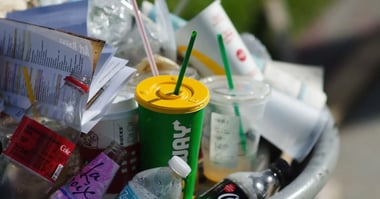
Tamara Davison
Tamara Davison is a journalist who specializes in sustainability and the environment. Reporting from around the world, she's seen firsthand the direct impact waste is having on coastal communities and our oceans. As a diver trained in ecological monitoring, the changes Tamara has seen in marine habitats inspired her to action. She's previously written for The Guardian, The Independent and the Evening Standard. She's also produced environmental documentaries for EuroNews.
According to a 2023 Sustainability Sector Index, more than half of consumers believe brands have misled them about sustainability claims.
Greenwashing is a massive concern for most businesses, as it can negatively impact a brand’s relationship with its most important partner: the consumer.
While some people associate plastic neutrality with carbon neutrality, which has been criticized recently for its ties to greenwashing, the similarities between the two practices end with their names.
Adopting a plastic neutrality model can help your brand make a difference when part of a broader plastic reduction plan. When carried out correctly and part of a wider plan, it’s far removed from greenwashing — here’s what you need to know.
What’s on this page?
01 | What is plastic neutrality?
02 | Is plastic neutrality greenwashing?
03 | The benefits of plastic neutrality
04 | Weaknesses of plastic neutrality
05 | How can businesses go plastic-neutral effectively?
06 | Summary
What is plastic neutrality?
Plastic neutrality is the term used to describe a brand’s effort to balance its plastic footprint by recovering an equivalent amount of plastic waste from the environment. This makes the company’s plastic output and recovery neutral.
Ideally, we’d love to see brands replace single-use and virgin plastic packaging with alternative materials — but we know that’s not always easy.
Plastic neutral brands collect, remove, and usually recycle plastic waste from the environment to
offset their plastic output.
This strategy allows brands that use plastic in their operations to still take responsibility for their waste.
The idea is for businesses to recover and recycle an equal (or greater) amount of plastic than they produce to minimize their broader environmental impact.
Want to learn more? Check out our guide What Is Plastic Neutrality?
Is plastic neutrality greenwashing?
Like many environmental initiatives, plastic neutrality isn’t greenwashing when implemented correctly.
Over 350 million metric tonnes of plastic waste is generated worldwide each year, so the need for action is urgent. Leaving this waste in our environment or landfills will do more harm than good.
When done right, plastic neutrality motivates businesses to support those on the front lines of the plastic crisis. And more importantly, it provides immediate financial support to low-income areas that don’t currently have the funds to implement waste infrastructure.
It allows mountains of plastic waste to be collected from the ocean, which would otherwise pollute the environment and negatively impact wildlife. It’s not a silver bullet, but many reputable organizations agree that this strategy can make a difference.
In 2021, the World Wildlife Fund (WWF) said plastic crediting was ‘promising,’ acknowledging the potential benefits, while calling for strict guidelines to maintain the integrity of this practice.
Research conducted by the International Solid Waste Association (ISWA) similarly concluded that plastic credit schemes encourage the private sector to invest in social and environmental projects.
Plastic credits were also a big topic of discussion regarding the UN’s Global Plastic Treaty, where a chorus of brands said it could help bridge funding gaps in the waste industry. In early 2024, a UNEP financial statement stressed the crucial importance of financing practices that “help scale collection, sorting, and recycling systems.”
In fact, the UN summed it up perfectly:
“Plastic credit mechanisms can play a significant role within sustainable waste management systems along with local and national policies such as producer responsibility schemes and waste prevention and reduction laws.”
The statement also warns that credits “can also be a potential tool for greenwashing if not implemented properly. Plastic credits are not a long-term solution but rather a short-term remedy while we move to better waste and resource management systems."

What do we mean by implementing plastic credits “correctly”?
All of the above statements call for a nuanced approach to plastic credits. They acknowledge the potential financial benefits but suggest this strategy isn’t impactful on its own.
When plastic neutrality is adopted alongside other plastic initiatives, such as reducing plastic packaging or making products recyclable, it can help amplify immediate efforts to reduce plastic waste.
Partnering with a plastic credits organization that ensures transparency and verifies waste recycling enhances the project's validity and reduces the risk of greenwashing.
The benefits of plastic neutrality
In 2023, the World Economic Forum said, “new financial instruments, such as plastic credits, are emerging to incentivize plastic waste collection.” This was followed by the World Bank launching a bond to support plastic credit collection systems the following year. In short, there’s a lot of interest in this field.
So, how exactly can this benefit and incentivize businesses?
Holds businesses accountable
Businesses that achieve plastic neutrality ultimately tell their customers they care about the environment. This helps build trust and enhance your reputation among a growing cohort of conscious consumers.
On top of that, plastic credit systems that enable plastic neutrality often rely on advanced technology and reporting to deliver results. So, these claims can be verified against hard statistics, helping to validate your sustainability claims.
At CleanHub, we use track-and-trace technology and photographs from on the ground to verify the collections and ensure they’re properly managed. Brands can use our reporting to showcase their sustainability credentials to customers, regulators, and government bodies.
Introduces plastic recovery in vulnerable areas
Over 2 billion people lack access to basic waste management systems, and up to one million deaths in low-income countries are linked to pollution. These areas usually suffer from other challenges, including poor sanitation, lack of access to drinking water, and a lower quality of life.
Most plastic credit systems invest in these coastal communities, diverting funds to those most impacted by the climate crisis. By creating jobs in waste management, plastic neutrality programs establish solutions in areas where this doesn’t exist.
It’s an immediate solution
Traditional recycling operations sometimes take years to implement and scale up — not to mention, they’re extremely expensive. Plastic credit practices can speed up these processes, enabling a ‘rapid response’ approach to the mounting plastic crisis.
Plastic credit systems often rely on existing recycling infrastructure to support their projects. For example, many of our projects at CleanHub involve working with local waste collectors, while hiring additional teams to process any non-recyclable waste that’s been collected.
Adheres to legislation
Brands are increasingly expected to take responsibility for their waste, with measures like Extended Producer Responsibility (EPR) requiring businesses to consider the complete lifecycle of their products — not just the creation of them. Additionally, the UK’s Plastic Tax Treaty encourages brands operating in the country to use recycled materials.
Companies that fail to comply with local legislation can face considerable fines. Plastic credits and subsequent plastic neutrality help companies meet these regulatory requirements, providing tangible proof of their work in the form of reporting and data.
Funds projects in low-income areas
High levels of plastic pollution have been linked to poverty. Plastic credit funding is often channeled into low-income regions most impacted by the plastic pollution. But that’s not all: this funding also unlocks education and training, and helps build broader infrastructure that enhance social and economic development in areas that need it the most.
Weaknesses of plastic neutrality
We believe plastic neutrality is a force for good and offers many benefits when implemented properly. However, there are also some setbacks — we’ve listed the top examples below.
Lack of standardization in the plastic credits space
To achieve plastic neutrality, most brands will rely on plastic credit organizations, such as CleanHub, rePurpose, Verra, Plastic Credit Exchange, and Waste4Change.
However, plastic credit systems aren’t currently standardized. While organizations like the UN are now considering plastic credits, there’s still no global agreement on how they should work.
This means the value of credits can vary depending on the certifying body, making it difficult to ensure accountability and authenticity. It can also lead to inconsistency in the quality and impact of funded projects.
As more brands start to recognize the value of plastic neutrality, some standardization will likely come into play. For example, we might see the emergence of a global accreditation body that ensures all credit providers operate in the same way.
We’re currently the only plastic credit facilitator to be verified by TÜV SÜD ISO, meaning a certified sustainability regulator already vouches for our work. This brings a new level of transparency and rigor to the plastic credit industry and (we hope) will set a precedent among credit organizations.
Transparency varies from company to company
It's easy for brands to claim to be plastic neutral, but you need to back up any environmental statements with evidence, or it could be deemed greenwashing. While a variety of organizations can help you achieve plastic neutrality, not all of them are transparent about their operations.
With so much technology at our fingertips, plastic credit organizations are well-positioned to leverage this to support the environment.
That’s why, at CleanHub, we utilize trash-tracking technology, which uses QR codes to create an audit trail, ensuring traceability and accountability in our operations.
These data points can be shared with regulators, partners, and consumers, enhancing clear communication about the impact of each plastic waste collection.
It’s not a silver-bullet solution
Plastic neutrality doesn’t come without its challenges — after all, even plastic-neutral brands may still create plastic that impacts our environment.
It is, however, a step in the right direction. This is important for brands as it helps them showcase their seriousness about the environment.
Reducing plastic usage, enhancing recycling systems, developing sustainable packaging alternatives, and fostering a circular economy allows for a more comprehensive approach.
Brands that adopt a multi-pronged approach to plastic waste will likely get the most from plastic neutrality. By approaching plastic from all angles, you can build more sustainable systems into your business model — helping you grow and support the planet at the same time.
It’s not always clear what happens to the recovered plastic
Due to the lack of regulation in the plastic credit space, it’s not always clear what happens to the plastic that’s recovered in different collection projects. In this instance, for all we know, plastic could be collected and then sent straight to landfill, where it’ll generate more emissions and even get swept back into the environment during stormy weather.
Failure to communicate what happens to plastic after collections can lead to greenwashing allegations, and can negatively impact the validity of the plastic credit market.
So, if you want to become plastic neutral, make sure you choose a plastic credit partner that provides a clear overview of each step in the process — like CleanHub.
With us, you can see exactly where your investment goes — featuring images of the team collecting waste on your behalf and showcasing how operations work.
Failure to manage plastic waste, or communicate what happens after collections can lead to greenwashing allegations and negatively impact the validity of the plastic credit market.
To combat this, brands should look for plastic credit partners that provide a clear overview of each step in the process. With CleanHub, you can see exactly where your investment goes — featuring images of the team collecting waste on your behalf and showcasing how operations work.
How can businesses go plastic neutral effectively?
By partnering with CleanHub, you can effectively achieve plastic neutrality while ensuring transparency, authenticity, and measurable impact.
And it’s a win-win for everyone involved. We help you reduce your plastic footprint, you get real-time reporting, and your consumers get clear communication about your sustainable impact.
The results speak for themselves.
You’d be joining hundreds of leading companies that have teamed up with us to make a difference, helping us collect more than 9,529,204kg of waste so far (as of August 2024).
Making plastic neutrality part of a wider plan
If the planet continues its current trajectory, humans will produce 1,100 million tons of plastic waste annually by 2050.
These shocking findings require radical action, and achieving plastic neutrality is only one part of that.
While we can help your brand take steps toward curbing plastic waste, you can’t just rely on offsets — the rest is in your hands.
From replacing plastic with alternative materials to educating consumers about their role in the global plastic crisis, plastic credits must form part of a broader initiative to reduce plastic use.
All of this is part of working toward a circular economy, where materials remain in circulation and don’t become waste in the first place.
Summary
Plastic neutrality won’t work alone, but it can be a meaningful and practical way to help you kickstart your sustainability journey.
Striving for plastic neutrality is a good first step, and it encourages you to consider your brand’s long-term impact.
The best part about going plastic neutral is that you don’t have to do it alone. Plastic credit providers (like CleanHub) offer expert support at every step to help your brand have the right impact.
Ready to join hundreds of brands on the path to plastic neutrality? Speak to our experts today to learn more about how CleanHub can help.














